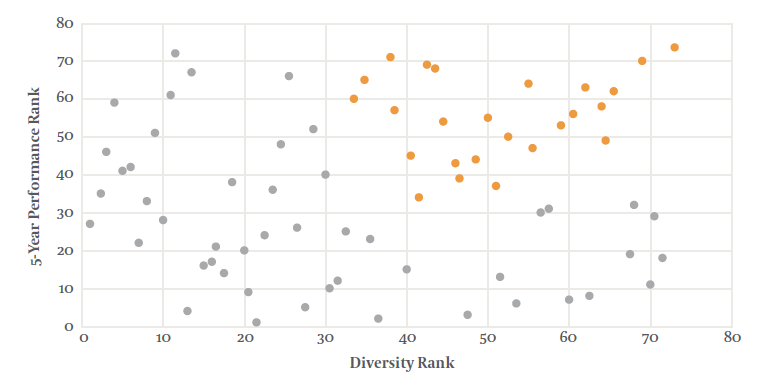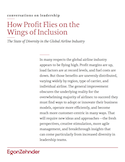In many respects the global airline industry appears to be flying high. Profit margins are up, load factors are at record levels, and fuel costs are down. But those benefits are unevenly distributed, varying widely by region, type of carrier, and individual airline. The general improvement obscures the underlying reality for the overwhelming majority of airlines: to succeed they must find ways to adopt or innovate their business models, operate more efficiently, and become much more customer-centric in many ways. That will require new ideas and approaches – the fresh perspectives, creative stimulation, more agile management, and breakthrough insights that can come particularly from increased diversity in leadership teams.
From making better decisions to tapping into diverse markets to fostering innovation, diversity is not only a value, it’s valuable. But when it comes to diversity, much of the global airline industry remains stuck on the ground. That is the central finding of Egon Zehnder’s study of the state of diversity in the airline industry today. Encompassing nearly 1300 executives and 73 airlines around the world, the study examined eight criteria of diversity:
- Age
- Gender
- Nationality
- International experience
- Experience in other industries, experience with other airlines
- Tenure with current airline
- Tenure in the airline sector
Our findings confirm the widespread perception that leadership teams throughout the industry are largely homogeneous:
- At most airlines, leaders in key leadership roles are long tenured in the industry and with their current airline. Those key roles, both Chief Executive Officers and senior Managing Directors in charge of business units and/or subsidiaries and senior executives of core airline operations, maintenance and engineering functions and the like, are occupied by executives who have been with their current airline for an average of 12 years and in the industry for an average of 18 years. Only 34% have worked in at least one other industry, and just 33% have worked for at least one other airline.
- Women are a rarity among CEOs or in other top executive positions. Less than 5% of CEOs and less than 13% of top executives are female. Despite some small improvement in female diversity recently, few women are found in key functions of airlines. Instead, they are concentrated in classic support functions such as Finance, PR or Human Resources.
- Cultural and national diversity is largely lacking. Only 18% of airline executives differ in nationality from their airline.
- In general, low-cost carriers (LCCs) perform better and have significantly higher diversity. Conversely, traditional Network carriers tend to be much less diverse in their leadership and many also struggle with business performance.
- A comprehensive cluster analysis reveals that among the economically top performing 15 airlines in this study, there is a systematically higher diversity of top executives across nearly all diversity criteria compared to the remaining clusters of airlines. When using conventional multi-variate linear correlation analysis, however, only a moderately positive dependence between level of diversity and compound economic performance can be identified. This is not a surprise in light of the weight of less controllable exogenous factors like fuel prices that impact airlines´ business performance.
The finding that the LCCs among the top airlines both achieve better business performance and exhibit greater diversity raises the question as to whether diversity of leadership teams tends to foster a spirit and culture in favor of fresh ideas, openness towards change, agility in taking fast decisions, but also stronger customer orientation and strong execution discipline. Successful LCCs also certainly enjoy the advantage of a clearly defined business model. In our previous study of the industry, “Flying Higher in Stormy Weather,” conducted in 2011, we maintained that “success will depend on the ability of each company – new or established – to develop, articulate, and execute on a distinctive and disciplined business model,” a contention that these LCCs seem to bear out.
We also found performance on diversity varies widely by region:
- Asian airlines underperform the industry across all eight categories of diversity.
- Pacific (Australia/New Zealand and small islands) airlines lead across all categories except experience at other airlines and experience abroad.
- European airlines stand at or near the industry-wide averages in most categories.
- Latin American airline executives are among the younger, on average, and they are strong in experience at different airlines, but very low in gender diversity.
- North America ranks lowest in national diversity but ranks above the industry average on gender diversity.
- Middle East and Africa (MEA) rank lowest in gender diversity but highest in the percentage of executives who have lived abroad.
Some of these results may be partially attributed to the business models and histories of the carriers in these regions. For example, the Middle Eastern/Gulf carriers were created to pursue business models built around connecting global source markets with globally spread destinations. In addition, in categories where a region’s or an airline’s performance is relatively high, optimism may not be entirely justified. For example, across all airlines and regions, the majority of female executives are concentrated in functions like Human Resources and Public Relations. Similarly, many executives who have come from other industries and airlines are clustered in areas with easily transferable strongly functional skills, above all finance, legal, and IT.
Learning from the best
Of the 73 airlines studied, the group of the top 15 airlines has achieved both markedly greater diversity in all categories and superior business performance over the past ten years (see chart). Of course correlation is not causation. And much that affects business performance – fuel prices, political turmoil, local market policies, regulation, and more – is not under the control of the airlines themselves. Nevertheless, the apparent connection is extremely suggestive. And as we found in our 2011 aviation study “Flying Higher in Stormy Weather: Developing the New Leaders for Aviation Success”, most airline CEOs consider diversity in the broadest sense an important source of business vitality.
Diversity Cluster

- The top right cluster shows the stars in diversity and success
- The top airlines come from a variety of regions, history, business models, and philosophies
- The unifying concept is strongly lived diversity & inclusion as well as rigor, focus, and passion in the execution and enhancement of the business model
Differences can make a difference
What can airlines do to improve their performance on diversity?
- Lead cultural revolution from the top. The ability to foster and manage diversity should be a well-developed part of the leadership competencies of all top executives.
- When recruiting, widen the talent pool. Include candidates who are not only diverse in terms of age, gender, and nationality, but also in the other dimensions of diversity. Diversity in its broadest sense can help overcome group-think, uncover opportunities in new services and markets, and appeal to a wide range of customers.
- Make sure diversity is accompanied by inclusion. That means a company culture which genuinely values and leverages the advantages of diversity. Do not simply assimilate diverse hires into the dominant group; enable their differences to flourish, complement each other, and be put to work.
Although the value of diversity is hard to quantify, its benefits can be enormous. Companies that put diversity to work are able to convert diverse perspectives into previously unrecognized opportunities in services and markets. They appeal to increasingly diverse customers. They attract talent from whatever sources. And they boost the productivity and effectiveness of operations across borders and cultures. For these companies, differences make a difference, continually renewing the business and producing benefits that are hard to measure but easy to see.
Access the full paper How Profit Flies on the Wings of Inclusion.

How Profit Flies on the Wings of Inclusion
Download as PDF
In the news:
Forbes Magazine - Global Airline Industry: Diversity Is Stuck On The GroundThe Independent – How Airlines Can Boost Bottom Line With Leadership DiversityFinancial Times – The old guard is in danger of burnout





